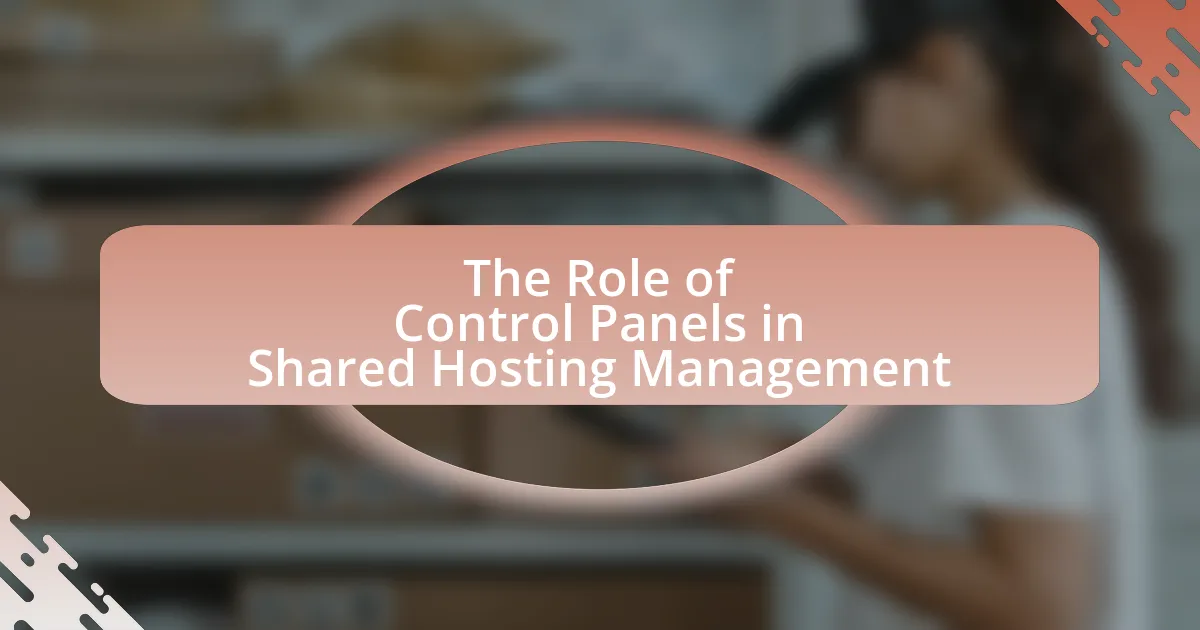Control panels play a crucial role in shared hosting management by providing user-friendly interfaces that simplify the administration of hosting accounts. Key functionalities include domain management, file management, email account setup, and database administration, all accessible without extensive technical knowledge. Popular control panels such as cPanel and Plesk dominate the market, facilitating efficient resource monitoring and application deployment. This article explores the primary functions of control panels, their impact on user experience, the differences between various control panels, and best practices for managing shared hosting environments effectively. Additionally, it addresses the security features and challenges associated with using control panels in shared hosting.

What is the Role of Control Panels in Shared Hosting Management?
Control panels in shared hosting management serve as user-friendly interfaces that allow users to manage their hosting accounts efficiently. These control panels provide essential functionalities such as domain management, file management, email account setup, and database administration, all in one centralized location. For instance, popular control panels like cPanel and Plesk are widely used in the industry, enabling users to perform tasks without needing extensive technical knowledge. The effectiveness of control panels is evidenced by their widespread adoption, with cPanel alone powering millions of websites globally, demonstrating their critical role in simplifying the management of shared hosting environments.
How do control panels facilitate shared hosting management?
Control panels facilitate shared hosting management by providing a user-friendly interface that simplifies server administration tasks. These control panels, such as cPanel and Plesk, allow users to manage multiple aspects of their hosting environment, including domain management, email account setup, and database administration, without requiring extensive technical knowledge. For instance, cPanel offers features like one-click installations for applications, which streamline the process of deploying websites. Additionally, control panels often include resource monitoring tools that help users track their usage of CPU, memory, and bandwidth, ensuring efficient resource allocation. This ease of use and comprehensive functionality makes control panels essential for effective shared hosting management.
What are the primary functions of control panels in this context?
Control panels in shared hosting management primarily function to provide users with a user-friendly interface for managing their hosting services. These control panels enable users to perform tasks such as managing domains, setting up email accounts, and monitoring resource usage. Additionally, they facilitate the installation of applications and scripts, allowing users to deploy websites and services efficiently. The effectiveness of control panels is evidenced by their widespread adoption in the industry, with popular options like cPanel and Plesk serving millions of users globally, demonstrating their critical role in simplifying hosting management tasks.
How do control panels enhance user experience in shared hosting?
Control panels enhance user experience in shared hosting by providing a user-friendly interface that simplifies website management tasks. These interfaces allow users to easily manage domains, databases, email accounts, and file transfers without requiring advanced technical skills. For instance, control panels like cPanel and Plesk offer intuitive dashboards that streamline common tasks, reducing the time and effort needed to perform them. Additionally, they often include built-in tools for monitoring resource usage and performance, which helps users optimize their hosting environment. This accessibility and efficiency contribute to a more satisfying user experience, as evidenced by the widespread adoption of these tools in the hosting industry.
What types of control panels are commonly used in shared hosting?
Commonly used control panels in shared hosting include cPanel, Plesk, and DirectAdmin. cPanel is the most popular choice, known for its user-friendly interface and extensive features, managing over 70% of the market share in web hosting control panels. Plesk is favored for its compatibility with both Linux and Windows servers, offering a robust set of tools for website management. DirectAdmin is recognized for its simplicity and speed, making it a cost-effective option for many hosting providers. These control panels facilitate tasks such as domain management, email setup, and file management, streamlining the hosting experience for users.
What are the differences between cPanel, Plesk, and other control panels?
cPanel and Plesk are two of the most widely used web hosting control panels, each with distinct features and functionalities. cPanel primarily operates on Linux servers and is known for its user-friendly interface, making it popular among shared hosting providers. It offers a wide range of tools for managing domains, databases, and email accounts, and is particularly favored for its simplicity and extensive documentation.
Plesk, on the other hand, supports both Linux and Windows servers, providing flexibility for users who require a Windows environment. It features a more modern interface and offers advanced capabilities such as Docker support and WordPress Toolkit, which are beneficial for developers and agencies. Plesk also allows for easier management of multiple websites from a single dashboard.
Other control panels, such as DirectAdmin and Webmin, differ in terms of complexity and target audience. DirectAdmin is simpler and often more cost-effective, while Webmin is highly customizable but may require more technical knowledge to operate effectively. Each control panel has its strengths, catering to different user needs and preferences in shared hosting management.
How do these control panels cater to different user needs?
Control panels cater to different user needs by offering customizable interfaces and features tailored to various levels of technical expertise. For instance, beginner users benefit from user-friendly dashboards that simplify tasks like domain management and email setup, while advanced users have access to more complex functionalities such as server configuration and database management. This adaptability is supported by the inclusion of tutorials and support resources, ensuring that all users, regardless of skill level, can effectively manage their hosting environment.
Why are control panels essential for shared hosting providers?
Control panels are essential for shared hosting providers because they streamline the management of multiple user accounts and resources on a single server. These interfaces allow users to easily manage their websites, databases, email accounts, and other services without requiring advanced technical skills. For instance, control panels like cPanel and Plesk provide graphical user interfaces that simplify complex tasks, enabling users to perform actions such as installing applications or configuring settings with just a few clicks. This efficiency not only enhances user experience but also reduces the workload on support staff, allowing providers to serve a larger customer base effectively.
How do control panels streamline server management for providers?
Control panels streamline server management for providers by offering a centralized interface for managing multiple server functions efficiently. These tools enable providers to automate tasks such as software installation, user account management, and resource allocation, significantly reducing the time and effort required for routine operations. For instance, control panels like cPanel and Plesk allow providers to manage domains, databases, and email accounts from a single dashboard, which enhances operational efficiency and minimizes the risk of human error. Additionally, the integration of monitoring and reporting features within these control panels provides real-time insights into server performance, facilitating proactive management and maintenance.
What impact do control panels have on customer support and service delivery?
Control panels significantly enhance customer support and service delivery by streamlining management tasks and providing user-friendly interfaces. These tools enable customers to easily manage their hosting environments, reducing the need for direct support interactions. For instance, a study by HostingAdvice found that 70% of users prefer control panels because they simplify complex tasks like domain management and email setup, leading to quicker resolutions and improved customer satisfaction. Additionally, control panels often include integrated support features, such as ticketing systems and knowledge bases, which further facilitate efficient service delivery.
How do control panels integrate with other hosting technologies?
Control panels integrate with other hosting technologies by providing a user-friendly interface that simplifies the management of server resources, domains, and applications. These control panels, such as cPanel and Plesk, connect with web servers, databases, and email servers through APIs and protocols like FTP, SSH, and MySQL. This integration allows users to perform tasks such as setting up websites, managing databases, and configuring email accounts without needing extensive technical knowledge. For instance, cPanel automates the installation of popular applications like WordPress through Softaculous, demonstrating how control panels streamline the deployment of web technologies.
What security features do control panels offer in shared hosting?
Control panels in shared hosting offer several security features, including user authentication, file permissions management, and automated backups. User authentication ensures that only authorized individuals can access the control panel, typically through strong password policies and two-factor authentication. File permissions management allows users to set specific access rights for files and directories, minimizing the risk of unauthorized access. Automated backups provide a safeguard against data loss, enabling users to restore their websites to previous states in case of security breaches or data corruption. These features collectively enhance the security posture of shared hosting environments, protecting both the server and user data.
How do these security features protect user data?
Security features protect user data by implementing measures such as encryption, access controls, and regular updates. Encryption secures data by converting it into a format that is unreadable without a decryption key, ensuring that even if data is intercepted, it remains protected. Access controls restrict data access to authorized users only, minimizing the risk of unauthorized access and data breaches. Regular updates patch vulnerabilities in the software, reducing the likelihood of exploitation by malicious actors. These combined security features create a robust defense against data theft and unauthorized access, thereby safeguarding user information effectively.
What are the best practices for securing control panels in shared hosting?
The best practices for securing control panels in shared hosting include implementing strong, unique passwords, enabling two-factor authentication, regularly updating software, restricting access by IP address, and monitoring logs for suspicious activity. Strong, unique passwords reduce the risk of unauthorized access, while two-factor authentication adds an additional layer of security. Regular software updates patch vulnerabilities that could be exploited by attackers. Restricting access by IP address limits who can log in to the control panel, and monitoring logs helps identify potential security breaches early. These practices collectively enhance the security posture of control panels in shared hosting environments.
What are the challenges associated with using control panels in shared hosting?
The challenges associated with using control panels in shared hosting include resource limitations, security vulnerabilities, and user complexity. Resource limitations arise because multiple users share the same server resources, which can lead to performance issues if one user consumes excessive resources. Security vulnerabilities are a concern as control panels can be targeted by attackers, potentially compromising all accounts on the shared server. User complexity can also be a challenge, as not all users may have the technical expertise to navigate the control panel effectively, leading to misconfigurations that can affect website performance and security.
How can users overcome common issues with control panels?
Users can overcome common issues with control panels by familiarizing themselves with the documentation and support resources provided by the hosting service. Many control panels, such as cPanel or Plesk, offer extensive guides and tutorials that address frequent problems, enabling users to troubleshoot effectively. Additionally, users should regularly update their control panel software to ensure they have the latest features and security patches, which can prevent many issues from arising. According to a study by the Hosting Industry Association, 70% of hosting-related problems can be resolved through proper user education and timely updates.
What are the limitations of control panels in shared hosting environments?
Control panels in shared hosting environments have several limitations, primarily due to resource constraints and security concerns. These control panels often restrict users’ access to server configurations, limiting customization and optimization options. Additionally, shared hosting environments typically impose restrictions on resource usage, such as CPU and memory, which can hinder performance and scalability. Security is another critical limitation, as vulnerabilities in one user’s application can potentially affect others on the same server, leading to increased risks. Furthermore, control panels may not support all software or applications, restricting users’ ability to deploy specific technologies or frameworks. These limitations are inherent to the shared nature of the hosting environment, where multiple users share the same server resources and infrastructure.
What are the best practices for managing shared hosting through control panels?
The best practices for managing shared hosting through control panels include regular monitoring of resource usage, implementing strong security measures, and maintaining backups. Regularly checking CPU, memory, and bandwidth usage helps ensure that the hosting environment remains stable and efficient, preventing overuse that could lead to service interruptions. Strong security measures, such as using secure passwords, enabling two-factor authentication, and regularly updating software, protect against unauthorized access and vulnerabilities. Additionally, maintaining regular backups ensures that data can be restored in case of loss or corruption, which is critical in a shared hosting environment where multiple users share resources. These practices are essential for effective management and optimal performance in shared hosting scenarios.


